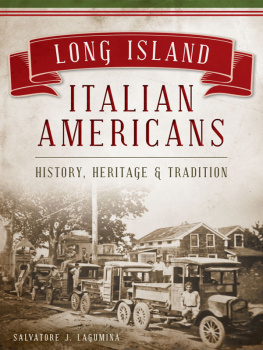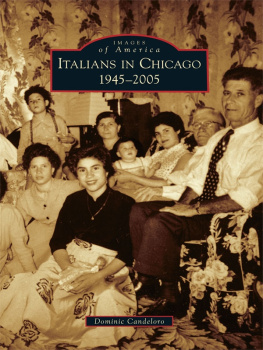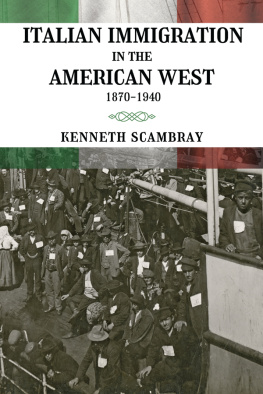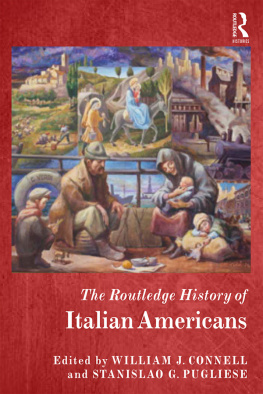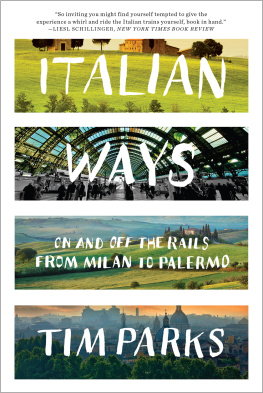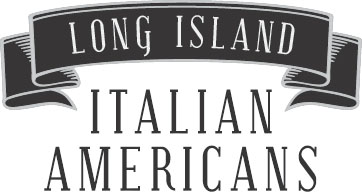

Published by The History Press
Charleston, SC 29403
www.historypress.net
Copyright 2013 by Salvatore J. LaGumina
All rights reserved
First published 2013
e-book edition 2013
Manufactured in the United States
ISBN 978.1.61423.999.4
Library of Congress Cataloging-in-Publication Data
LaGumina, Salvatore John, 1928
Long Island Italian Americans : history, heritage and tradition / Salvatore J. LaGumina.
pages cm. -- (American heritage)
print edition ISBN 978-1-60949-870-2 (pbk.)
1. Italian Americans--New York (State)--Long Island--History. 2. Long Island (N.Y.)--History. I. Title.
F127.L8L343 2013
305.851073074721--dc23
2013027701
Notice: The information in this book is true and complete to the best of our knowledge. It is offered without guarantee on the part of the author or The History Press. The author and The History Press disclaim all liability in connection with the use of this book.
All rights reserved. No part of this book may be reproduced or transmitted in any form whatsoever without prior written permission from the publisher except in the case of brief quotations embodied in critical articles and reviews.
CONTENTS
INTRODUCTION
This is a study of American history, but more precisely, it is a study of an aspect of American historythe ethnic dimension as it figured in the development of Long Island, New York history. It is concerned with the factors and forces that were operative over the past century and a quarter as Italian immigrants and their issue moved into an area of New York that is home to millions of people and is one of the most prosperous and vibrant areas of the country. The migration of Italian Americans into the longest island on the eastern seaboard of the United States began during a time when Long IslandNassau and Suffolk Countieswas rural, bucolic and sparsely populated and reached its height in the postWorld War II era that witnessed massive movement from the city to the suburbs. The Long Island explosion in housing, population, industry, construction, education and a variety of social, cultural, religious and political initiatives became a prototype for a nation on the move. This volume focuses on Italian Americans who formed the largest cohort of this important development. To learn their history is to learn much about recent American history.
Chapter 1
STIRRINGS
For over a generation, Italian Americansa term that encompasses those whose ancestry includes at least one parent or ancestor of Italian descent as well as those who identify themselves as Italian American in the United States censushave been the largest single ethnic/nationality group on Long Island. Into the second decade of the twenty-first century, they represent about one of every four residents of Nassau and Suffolkthe two counties commonly referred to as Long Island in contradistinction to the inclusion of Queens and Brooklyn, which are physically part of the island landmass. As such, their numbers in the two counties constitute the largest concentration of people of Italian descent in two contiguous counties outside Italy.
The history of Italian immigration to Long Island, while unique in many respects, largely mirrors the saga of mass immigration that embraced the years from the late 1880s to World War I. Known as the era of New Immigration, that period found millions of newcomers from eastern, central and southern Europe entering the nations expanding cities especially on the East Coast. Among the causes of immigration, in general, were religious and political persecution, as in the case of Russian Jews, and restricted educational prospects that offered little hope to aspire beyond their conventional station in life for Europeans as a whole.
A combination of push-pull factors was at work on Italian American immigrants in the decision to withdraw from the land of their birth and ancestors and from a society that reflected everything they held dear to a new country about which they knew little and where they would be distinctive minorities. Among the push factors were a desire to escape mandatory military service, the denial of opportunities to engage in meaningful political enterprises that governed their lives and conditions that precluded genuine opportunities to earn a livelihood for themselves and their families. Conversely, the pull factors, those that served as a distant magnet that enticed them to this new land, were the opposites of the expelling forces: freedom of religion, the possibility of participating in political pursuits, the seeming absence of a functioning rigid class structure, the availability of free basic education, the opportunity to rise above their families accustomed place in life and the greater possibility to find employment. For Italian immigrants, some, but not all, of these were involved in the decision to emigrate; clearly, the most important was the economic factor: the work opportunities and the chance to earn a salary to support themselves and their families. Even though by American standards a typical wage earned by an Italian immigrant was miserly, it was far more than he could earn in Italy at a similar position.

Italian American workers of Romeo Construction Company building Route 112 in Suffolk County.
Accordingly, although a people with a heritage of working the soil for a livelihood, Italian immigrants moved into large metropolitan centers such as New York City, where they began their ascendancy as the citys largest ethnic bloc and in the process became indelibly identified with Little Italy neighborhoods for generations. The pattern was repeated in large urban centers such as Philadelphia, Baltimore and Boston. Nevertheless, for the fortunate few from the outset, the lure of the land was fulfilled. To own the soil in which to build their homes, to raise their families and to grow familiar fig trees and other citrus fruits and vegetables was the dream that impelled them to bypass crowded and stench-filled tenements in congested and teeming cities for the more sparsely populated countrysidethe term suburb was not yet the popular designation. Thus it was that a handful of Italian enclaves on Long Island began to emerge by the early part of the twentieth century in both Nassau and Suffolk Counties, including, among others, Inwood, Westbury, Glen Cove and Port Washington in Nassau and Patchogue and Copiague in Suffolk.
A PROLETARIAN PEOPLE
Long Islands Italian immigration configuration likewise shadowed a familiar pattern of chain migration; namely, it followed the journey of family members and village pioneers whose primary focus was to search out work and settlement possibilities. Italian immigrants were decidedly a proletarian element, a fact borne out by official census figures of the periodthey possessed a lesser amount of capital per individual than virtually all newcomers of that era. Another example from the New York state census of 1915 indicated that, in Patchogue, the overwhelming majority of Italian Americans were distinctly in common working-class occupations. The same census records demonstrated similar findings in Westbury, where 136 of 275 Italian male residents were in proletarian occupations. Unlike the enormous opportunities inherent in New York City in various fields such as construction, the garment industries and the printing trades, Long Island possessed few major industries, specifically only a handful, including sand mining, horticulture and the railroad industry. By the early 1900s, Italian immigrants and their children were becoming essential in all these businesses and, in some instances, continued to be important factors over the course of succeeding generations. Although frequently linked with other causes, the need to find a job was, of course, a compelling operative immigration factor with all newcomer groups, but for Italians, it was the dominant causative immigration factor. Departure from their homeland was not prompted by a desire to escape religious or political persecutionit was prompted by the opportunities to earn a living for themselves and their families. This was so pervasive a motivation that it was expressed in a common saying of the period: Italy was the land that gave you bread. Recalling that early period, one Italian immigrant to Westbury confessed he was given the epithet work because of his constant inquiry about job opportunities. Finding work was the guiding principle for most of the first wave of Italian newcomers whose goals were to earn money in America and then return to live in Italy, as many did.
Next page
